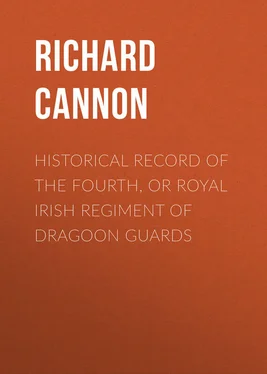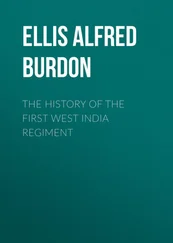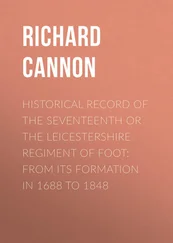Richard Cannon - Historical Record of the Fourth, or Royal Irish Regiment of Dragoon Guards
Здесь есть возможность читать онлайн «Richard Cannon - Historical Record of the Fourth, or Royal Irish Regiment of Dragoon Guards» — ознакомительный отрывок электронной книги совершенно бесплатно, а после прочтения отрывка купить полную версию. В некоторых случаях можно слушать аудио, скачать через торрент в формате fb2 и присутствует краткое содержание. Жанр: foreign_antique, foreign_prose, на английском языке. Описание произведения, (предисловие) а так же отзывы посетителей доступны на портале библиотеки ЛибКат.
- Название:Historical Record of the Fourth, or Royal Irish Regiment of Dragoon Guards
- Автор:
- Жанр:
- Год:неизвестен
- ISBN:нет данных
- Рейтинг книги:4 / 5. Голосов: 1
-
Избранное:Добавить в избранное
- Отзывы:
-
Ваша оценка:
- 80
- 1
- 2
- 3
- 4
- 5
Historical Record of the Fourth, or Royal Irish Regiment of Dragoon Guards: краткое содержание, описание и аннотация
Предлагаем к чтению аннотацию, описание, краткое содержание или предисловие (зависит от того, что написал сам автор книги «Historical Record of the Fourth, or Royal Irish Regiment of Dragoon Guards»). Если вы не нашли необходимую информацию о книге — напишите в комментариях, мы постараемся отыскать её.
Historical Record of the Fourth, or Royal Irish Regiment of Dragoon Guards — читать онлайн ознакомительный отрывок
Ниже представлен текст книги, разбитый по страницам. Система сохранения места последней прочитанной страницы, позволяет с удобством читать онлайн бесплатно книгу «Historical Record of the Fourth, or Royal Irish Regiment of Dragoon Guards», без необходимости каждый раз заново искать на чём Вы остановились. Поставьте закладку, и сможете в любой момент перейти на страницу, на которой закончили чтение.
Интервал:
Закладка:
Although a deep feeling of anxiety was general in the kingdom at this period, yet the King had declared his determination to support the Protestant religion, as by law established, and his designs against the constitution had not been manifested; hence loyalty to the sovereign, a principle so genial to the innate feelings of the British people, prevailed over every other consideration. A number of Mendip miners and other disaffected persons joined the Duke of Monmouth; but men of all ranks arrayed themselves under the banners of royalty.
To officers and soldiers imbued with a laudable esprit de corps , the particulars relating to the origin and services of their regiment are of intense interest, and the circumstances which gave rise to the formation of their corps are of themselves an era. To encourage such feelings is one of the objects of the present undertaking, and, although the general reader may think the narrative tedious, the officers and men of the Royal Irish Dragoon Guards will feel gratified at learning by whom, and where, each troop, of which their regiment was originally composed, was raised. This information has been procured from public documents, in which it is recorded that, in the midst of the hostile preparations which the Duke of Monmouth's rebellion occasioned in every part of the kingdom, a troop of horse was raised by James Earl of Arran, eldest son of William Duke of Hamilton, a nobleman distinguished alike for loyalty and attachment to the Protestant religion; a second troop was raised, in the vicinity of London, by Captain John Parker, Lieutenant of the Horse Grenadier Guards attached to the King's Own troop of Life Guards (now First Regiment of Life Guards); a third at Lichfield, by William Baggott, Esq.; a fourth at Grantham, by Thomas Harrington, Esq.; a fifth at Durham, by John Fetherstonhalgh, Esq.; and the sixth at Morpeth, by William Ogle, Esq.; and that, after the decisive battle of Sedgemoor had destroyed the hopes of the invader, these six troops were ordered to march to the south of England, and were incorporated into a regiment of Cuirassiers, which is now the Fourth or Royal Irish Regiment of Dragoon Guards. The Colonelcy was conferred on the Earl of Arran, by commission, dated the 28th of July, 1685; the Lieutenant-Colonelcy on Captain Charles Nedby, 7 7 Captain Charles Nedby commanded a troop in the Duke of Monmouth's regiment of horse, which was raised in 1678, in the expectation of a war with France, and was disbanded in the following year. In 1680 he raised an independent troop of horse for service at Tangier in Africa, and proceeding thither immediately, distinguished himself in an action with the Moors, on 27th of September, 1680. In 1683 the four troops of Tangier horse were constituted, together with two troops raised in England, the Royal Regiment of Dragoons. Captain Nedby continued in the Royal Dragoons until June, 1685, when he raised a troop of horse for the Queen's Regiment, now 1st Dragoon Guards; and in July of the same year he was appointed Lieutenant-Colonel of the Earl of Arran's Regiment.
from the Queen's regiment of horse; and the commission of Major on Captain John Parker.
At the formation of this regiment it ranked as Sixth Horse, but was distinguished by the name of its Colonel, the practice of using numerical titles not having been introduced into the British army until the reign of King George II. This corps being composed of the sons of substantial yeomen and tradesmen, who provided their own horses, it was held in high estimation in the country, and the men were placed on a rate of pay (2 s. 6 d. per day) which gave them a respectable station in society. Few nations in Europe possessed a body of troops which could vie with the English horse in all the qualities of good soldiers, and, in the reigns of King William III. and Queen Anne, this arme acquired a celebrity for gallantry and good conduct; and these qualities, whether evinced by bravery in the field, or by steadiness and temperate behaviour when their services have been required on home duties, have proved their usefulness, and have rendered them valuable corps during succeeding reigns.
The Earl of Arran's Regiment was armed and equipped, in common with the other regiments of Cuirassiers, with long swords, a pair of long pistols, and short carbines; the men wore hats, with broad brims bound with narrow lace, turned up on one side, and ornamented with ribands; large boots; and gauntlet gloves; their defensive armour was steel cuirasses, and head-pieces. This regiment was distinguished by white ribands, white linings to the coat, white waistcoats and breeches, white horse-furniture, the carbine belts covered with white cloth, and ornamented with lace, and the officers wore white silk sashes; – each regiment had a distinguishing colour, which was then called its livery , and which is now called facing , and the distinguishing colour of the Earl of Arran's Regiment was WHITE. 8 8 According to the estimates of this period, the following sums were usually paid for the clothing of the horse: — Each Captain clothed his own trumpeter, and the Colonel the kettle-drummer.
On their arrival in the south of England, Arran's Cuirassiers proceeded to the vicinity of Hounslow, and on the 20th of August passed in review before King James II. and his court on the heath. In order to make a display of his power and to overawe the disaffected in the kingdom, His Majesty ordered an army of eight thousand men to encamp on Hounslow Heath, of which this regiment formed a part; and on the 22nd of August the King reviewed twenty squadrons of horse, one of horse-grenadier guards, one of dragoons, and ten battalions of foot on the heath. After the review Arran's Cuirassiers marched into quarters at Winchester and Andover, where they arrived on the 5th of September.
In these quarters the regiment passed the succeeding winter; and on the 1st of January, 1686, its establishment was fixed by a warrant under the sign manual, from which the following is an extract: —
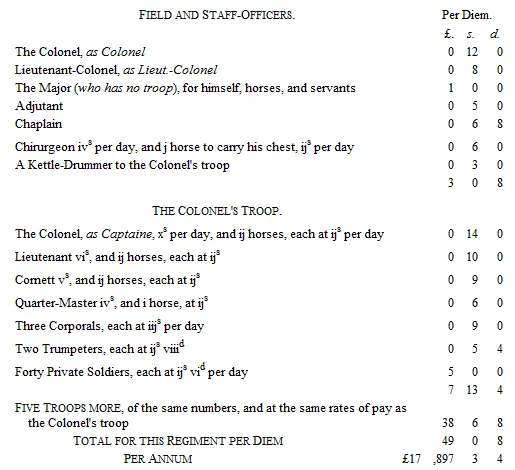
At this period the following officers were holding commissions in the regiment: —
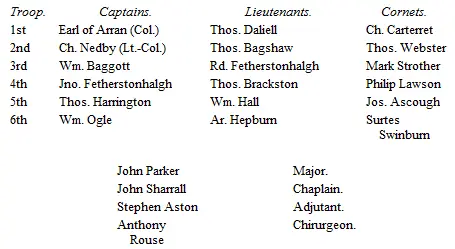
Arran's Cuirassiers were called from their cantonments in Hampshire in June, and again pitched their tents on Hounslow Heath, where they were reviewed several times by the King; and afterwards marched into quarters at Leicester, Ashby de la Zouch, Loughborough, and Melton Mowbray; and while in these quarters their Lieutenant-Colonel retired, and was succeeded by Major John Parker.
In the following summer they were withdrawn from Leicestershire, and proceeding to the metropolis, occupied quarters for a short time at Chelsea and Knightsbridge, from whence they proceeded to Hounslow, and again pitched their tents on the heath. After having been reviewed by the King, they marched (9th August) to Windsor and adjacent villages, and furnished a guard for the royal family at Windsor Castle; also a guard for the Princess Anne (afterwards Queen Anne) at Hampton Court Palace, and one troop was stationed at London to assist the Life Guards in their attendance on the Court.
On the 31st of August the regiment marched to London, and was quartered in Holborn, Gray's Inn Lane, and the vicinity of Smithfield, in order to take part in the duties of the court and metropolis; and in September it furnished a detachment to protect a large sum of money from London to Portsmouth.
Читать дальшеИнтервал:
Закладка:
Похожие книги на «Historical Record of the Fourth, or Royal Irish Regiment of Dragoon Guards»
Представляем Вашему вниманию похожие книги на «Historical Record of the Fourth, or Royal Irish Regiment of Dragoon Guards» списком для выбора. Мы отобрали схожую по названию и смыслу литературу в надежде предоставить читателям больше вариантов отыскать новые, интересные, ещё непрочитанные произведения.
Обсуждение, отзывы о книге «Historical Record of the Fourth, or Royal Irish Regiment of Dragoon Guards» и просто собственные мнения читателей. Оставьте ваши комментарии, напишите, что Вы думаете о произведении, его смысле или главных героях. Укажите что конкретно понравилось, а что нет, и почему Вы так считаете.
